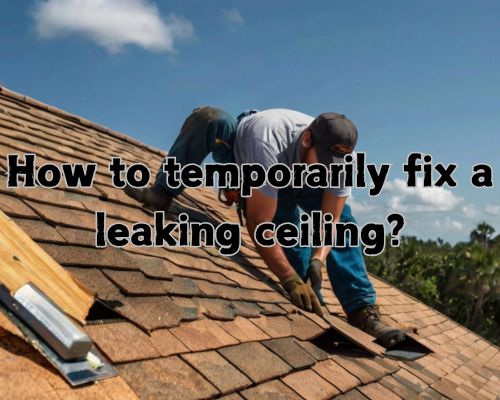How to Temporarily Fix a Leaking Ceiling: Quick Solutions

How to Temporarily Fix a Leaking Ceiling: Quick Solutions
Encountering a ceiling leak can be a homeowner’s nightmare, but swift action can minimize the damage and prevent further issues.
“To temporarily fix a leaking ceiling, you start by placing a bucket under the leak to catch dripping water and reduce water damage to your floors.” said Charles Jimerson from CJ Commercial Roofing NJ.

Once you’ve contained the immediate problem, your next step is to identify the leak’s source.
This might involve examining the roof or plumbing, depending on the location and nature of the leak.
A temporary fix is crucial until you can schedule a professional repair.
After securing the area, cover any exposed furniture with plastic tarps to shield it from further moisture.
If you’re able to access the attic or roof, laying a tarp over the suspected area might help to keep additional water from entering.
Lastly, puncturing a small hole in the ceiling at the point of water accumulation can help release water and relieve pressure.
Addressing water damage promptly is vital to preserve your home’s structural integrity and prevent mold growth.
By taking these initial steps, you manage the immediate situation effectively while preparing for a more comprehensive repair.
Identifying the Source and Mitigating Further Damage
Addressing a leaking ceiling promptly requires pinpointing the origin and taking steps to limit further damage.
By identifying whether the leak stems from faulty pipes, roof leaks, or condensation, you can take immediate action to protect the affected area. Let us get to understand more on these with Charles Jimerson from CJ Commercial Roofing NJ.
Locate the Leakage Point
Begin by examining signs of water damage such as pooled water, bubbled paint, and damp spots.
These indicators may help you identify the origin of the water intrusion.
Check the area above the ceiling for visible leaks, focusing on potential sources like faulty pipes and roof leaks.
Inspect plumbing systems as they are often hidden within ceilings and walls.
Evaluating connections and pipes for drips or signs of wear could determine if plumbing is a factor.
In some cases, leaks may be misidentified as roof problems, but understanding the specific causes will guide you in securing the area and planning for repairs.
Immediate Actions to Prevent Damage
To prevent further damage, implement temporary measures that contain water and protect your space.
Use a bucket or container under the leak to catch dripping water.
Placing drop cloths or plastic sheeting on the floor will protect surfaces from water exposure.
Consider using a plastic tarp to shield furniture and other items.
If water is collecting significantly, puncturing the ceiling with a screwdriver allows controlled drainage, preventing bigger ceiling damage.
Additionally, it is vital to document any damage and keep a record for insurance and future repairs, enabling a smooth restoration process once the leak is managed effectively.
Temporary Repair Techniques
Addressing a leaking ceiling quickly is essential to prevent further damage and maintain your home’s safety. Different strategies are necessary depending on the size of the leak and the potential for mold and mildew development.
Sealing Minor Leaks
For small leaks, first, identify the affected area and move any personal items to prevent water damage.
Use waterproof barriers like plastic sheets or tarps to cover the area.
Applying roofing tape can temporarily seal cracks or small holes.
If the leak is near drywall, patch it using spackle or joint compound.
Ensure the ceiling surface is dry before applying these materials.
This method is suitable for sealing minor imperfections and can help maintain the integrity of the ceiling until a permanent repair is possible.
Managing Larger Damage
In cases of larger damage, such as from a burst pipe or a significant roof issue, a more robust approach is necessary.
Cover the damaged ceiling with a sturdy tarp to redirect water away.
If drywall panels are affected, you might need to remove any severely compromised sections to prevent collapse or further saturation.
Consider installing a temporary waterproof barrier around the damaged site.
Use materials like tarps or heavy-duty plastic sheets.
If you detect extensive ceiling damage, it might be necessary to seek professional help to hang drywall ceiling or apply repairs that restore structural integrity.
Preventing Mold and Mildew
Water exposure can lead to mold growth and mildew, which are common in leaking ceilings.
To combat this, promptly dry the area using fans or dehumidifiers. Monitor for musty smells, as these might indicate hidden mold.
Inspect your ceiling and walls regularly. If necessary, apply anti-mold sprays or solutions.
Check wallpapers and paints for moisture damage, and replace them if needed. If the problem persists, use professional services to ensure complete removal and prevent future issues.
Keep your home well-ventilated to reduce moisture levels, crucial for minimizing mildew risk.

